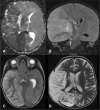Decompressive hemicraniectomy in pediatric malignant arterial ischemic stroke: a case-based review
- PMID: 37493722
- PMCID: PMC10432330
- DOI: 10.1007/s00381-023-06086-w
Decompressive hemicraniectomy in pediatric malignant arterial ischemic stroke: a case-based review
Abstract
Purpose: Malignant stroke is a life-threatening emergency, with a high mortality rate (1-3). Despite strong evidence showing decreased morbidity and mortality in the adult population, decompressive hemicraniectomy (DCH) has been scarcely reported in the pediatric stroke population, and its indication remains controversial, while it could be a potential lifesaving option.
Methods and results: We performed an extensive literature review on pediatric malignant arterial ischemic stroke (pmAIS) and selected 26 articles reporting 97 cases. Gathering the data together, a 67% mortality rate is observed without decompressive therapy, contrasting with a 95.4% survival rate with it. The median modified Rankin score (mRS) is 2.1 after surgery with a mean follow-up of 31.8 months. For the 33% of children who survived without surgery, the mRS is 3 at a mean follow-up of 19 months. As an illustrative case, we report on a 2-year-old girl who presented a cardioembolic right middle cerebral artery stroke with subsequent malignant edema and ongoing cerebral transtentorial herniation in the course of a severe myocarditis requiring ECMO support. A DCH was done 32 h after symptom onset. At the age of 5 years, she exhibits an mRS of 3.
Conclusion: Pediatric stroke with malignant edema is a severe condition with high mortality rate if left untreated and often long-lasting consequences. DCH might minimize the vicious circle of cerebral swelling, increasing intracranial pressure and brain ischemia. Our literature review underscores DCH as an efficient therapeutic measure management of pmAIS even when performed after a significant delay; however, long-lasting morbidities remain high.
Keywords: Craniectomy; Malignant edema; Pediatric stroke.
© 2023. The Author(s).
Conflict of interest statement
The authors have no financial or proprietary interest in any material discussed in this article.
Figures

Similar articles
-
Decompressive hemicraniectomy in pediatric patients with malignant middle cerebral artery infarction: case series and review of the literature.World Neurosurg. 2013 Jul-Aug;80(1-2):126-33. doi: 10.1016/j.wneu.2013.06.001. Epub 2013 Jun 19. World Neurosurg. 2013. PMID: 23791748
-
Prior Thrombectomy Does Not Affect the Surgical Complication Rate of Decompressive Hemicraniectomy in Patients with Malignant Ischemic Stroke.Neurocrit Care. 2024 Apr;40(2):698-706. doi: 10.1007/s12028-023-01820-3. Epub 2023 Aug 28. Neurocrit Care. 2024. PMID: 37639204 Free PMC article.
-
Decompressive hemicraniectomy for malignant middle cerebral artery infarction including patients with additional involvement of the anterior and/or posterior cerebral artery territory-outcome analysis and definition of prognostic factors.Acta Neurochir (Wien). 2018 Jan;160(1):83-89. doi: 10.1007/s00701-017-3329-3. Epub 2017 Sep 30. Acta Neurochir (Wien). 2018. PMID: 28965156
-
Decompressive hemicraniectomy in ischemic stroke.J Neurosurg Sci. 2021 Jun;65(3):249-258. doi: 10.23736/S0390-5616.20.05103-6. Epub 2020 Nov 30. J Neurosurg Sci. 2021. PMID: 33252206 Review.
-
Hemicraniectomy for malignant middle cerebral artery territory infarction: an updated review.J Neurosurg Sci. 2015 Mar;59(1):73-8. Epub 2014 Nov 25. J Neurosurg Sci. 2015. PMID: 25423133 Review.
Cited by
-
Severe Pediatric Open Skull Fracture With Exposed Brain Matter: A Case Report.Cureus. 2023 Oct 5;15(10):e46521. doi: 10.7759/cureus.46521. eCollection 2023 Oct. Cureus. 2023. PMID: 37927750 Free PMC article.
-
Decompressive craniectomy in children: indications and outcome from a tertiary centre.Childs Nerv Syst. 2024 Nov;40(11):3757-3764. doi: 10.1007/s00381-024-06513-6. Epub 2024 Jul 1. Childs Nerv Syst. 2024. PMID: 38953913
References
-
- Shah S, Murthy SB, Whitehead WE, Jea A, Michael Nassif L (2013) Decompressive hemicraniectomy in pediatric patients with malignant middle cerebral artery infarction: case series and review of the literature. World Neurosurg - PubMed
-
- Ramaswamy V, Mehta V, Bauman M, Richer L, Massicotte P, Yager JJ. Decompressive hemicraniectomy in children with severe ischemic stroke and life-threatening cerebral edema. J Child Neurol. 2008;23(8):889–894. - PubMed
-
- Back L, Nagaraja V, Kapur A, Eslick GD. Role of decompressive hemicraniectomy in extensive middle cerebral artery strokes: a meta-analysis of randomised trials. Internation Medicine journal. 2015;45:711–717. - PubMed
Publication types
MeSH terms
LinkOut - more resources
Full Text Sources
Medical
Research Materials

